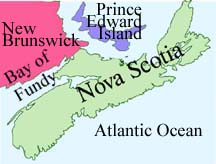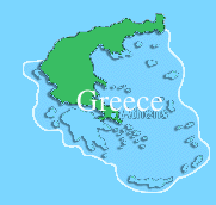|

|
|
About This Daily Classroom Special
Acadian Odyssey, created by Ron Dupuis, explores the culture of his ancestors by visiting "real" Cajun towns, presenting folk stories
and language, describing the unique Cajun way of cooking, and allowing web site visitors to experience numerous Cajun-related festivals in Southern Louisiana. Ron is a teacher at
Scotlandville Magnet High School in Baton Rouge (LA) and former Teachers Network web mentor.
Nova Scotian Roots
Long an area of rich fishing waters, the Northeastern Atlantic coast of present-day Canada became a focus point of interest for creating permanent agricultural communities
for the French in the 17th century. One of the first of these communities was Port-Royal in Acadia (today Annapolis Royal, Nova Scotia). The area was discovered in 1604 and the settlement
was founded the following year. It would be two years later when the English settled Jamestown, Virginia in 1607, making Port-Royal the first settlement in North America.
 Aboard the first ship to come to Nova Scotia's Bay of Fundy in July 1604 were
over 120, including crew and settlers. Wary of Indian tribes, these settlers came into contact with the Micmac tribe, who would later become instrumental in the Acadians' survival.
The appointed Captain-General at the time was Pierre du Gast, Sieur de Monts, a member of Henry IV's court in France. His instructions included populating, cultivating, and fortifying
the area, along with converting and trading with the Indians. Not a small task considering the land of Acadia covered an area which today includes Nova Scotia, New Brunswick, Prince
Edward Island, and part of present-day Maine. Later, after the area was ceded to Great Britain in 1713, Acadia was defined as only present Nova Scotia. Aboard the first ship to come to Nova Scotia's Bay of Fundy in July 1604 were
over 120, including crew and settlers. Wary of Indian tribes, these settlers came into contact with the Micmac tribe, who would later become instrumental in the Acadians' survival.
The appointed Captain-General at the time was Pierre du Gast, Sieur de Monts, a member of Henry IV's court in France. His instructions included populating, cultivating, and fortifying
the area, along with converting and trading with the Indians. Not a small task considering the land of Acadia covered an area which today includes Nova Scotia, New Brunswick, Prince
Edward Island, and part of present-day Maine. Later, after the area was ceded to Great Britain in 1713, Acadia was defined as only present Nova Scotia.
Problems Begin
During the first years of the colony, Port-Royal survived well despite a brief scurvy outbreak. Home-grown supplies were being stored that could last until the next crop.
Agriculturally the colony was flourishing, and soon economic problems occurred. The financial success was noticed back in France and others became interested in securing trading rights
within the fur industry in particular. As control of the colony changed hands over the years, religious factors became involved which eventually led to Protestant groups recalling loans
because of the arrival of Jesuit missionaries. Suddenly finding themselves deep in debt and no way to pay, the colonists were forced to fend for themselves, and with help of the Micmac
Indians, they survived and continued to grow.
Then, the British came. After founding Virginia in 1607, the British decided to rid the Atlantic coast of the French and attacked Port-Royal in October 1613. While they burned
the houses and stole provisions and cattle, the Acadians were hard at work in the fields nearby. But not near enough to warn them of the cowardly attack of the British. Returning
to their homes at the end of the day, all they found were ashes and smoldering remains.
The colonists had to quickly build shelter for the coming winter and once again, with the help of the Micmacs, found berries, roots, and vegetables to last the harsh winter months.
With infrequent support from their home country of France, the Acadians, out of necessity started becoming more and more self-sufficient in the New World.
The Acadians
Port-Royal was never left in peace. Acadia became the focal point of aggression and passed through the hands of French and British control numerous times. For over a century
this continued until in 1667 when the Treaty of Breda gave control to the French once again. Families continued to settle the area with a census being taken in 1671 showing 59 family
heads and a total of 320 people in all. By 1714, the population would increase to 2500.
Eventually, colonists began to branch out and new colonies of Beaubassin and Grand-Pré were founded. Acadian settlers began building dykes in order to reclaim land from
the sea that was useful for crops. Many extremely important jobs were handled, in part due to the strong sense of families working together to accomplish goals.
The Acadian family was often very large. Many generations of husbands and wives would live in the same household, instilled with a strong sense of family hierarchy. Many couples
would have 10, 15, or even 20 children and some 80-year-olds could boast of having 100 descendants; including children, grandchildren, and great-grandchildren.
With strong, heart-felt traditions in place, the people settling here felt a sense of belonging to each other. They had become Acadians in their hearts.
English Advancement
In 1688, war broke out between England and France. As a result, the angry British colonists swore to "capture Acadia and deport all the Acadians." But the British were held at bay
for a while. Later, they would return and successfully burn down parts of Grand-Pré and Beaubassin. Although great losses were acquired, Port-Royal continued to be the center
of French Acadia. This was again in large part due to the help of the Micmac Indians and the resourcefulness of the Acadians.
Because of domestic problems in France, Acadia was left once again without overseas support. The Acadians began taking food and supplies from British ships that sailed into their
region in order to survive these times. The British colonists became even more outraged.
The English arrived in Port-Royal on September 18th, 1710 and met some resistance from the valiant and brave Acadians who were extremely outnumbered but still fought to the best
of their abilities. Eventually, the English gained the upper-hand and Port-Royal was taken and renamed Annapolis Royal, after Queen Anne of Great Britain. Acadia became known as Nova
Scotia as the Treaty of Utrecht of 1713 formally ceded the area to England.
British Control
The British were kind enough to offer two options to the Acadians: stay in Acadia and become faithful servants of the Kingdom of Great Britain or "remove themselves" along with
their belongings. The English were clearly jealous and untrusting of the Acadians and their relationship with the local Indian tribes.
The British, fearing the Acadian allegiance to France as well as the drain from the colony if all French settlers would leave, urged for pledges of allegiance to the British crown.
Some Acadians did agree to this with various clauses attached, but most did not. The possibility of Acadian allegiance to Britain worried the Micmac Indians, afraid that their hunting
rights would be infringed upon by the British. Many Acadians hoped that the colony would once again be returned to French control. The British began to wonder if they should pursue
a more active approach of ridding the Acadians, but decided against it at the time because of fears of the "surrounding neighbors."
The Acadians began sensing the growing hostility towards them by the British and many wanted to move into French-controlled areas. But the persuasive British convinced them to stay
with words of encouragement that no actions would be taken against them. Afraid of Indian and French revolt against them, the British wanted to use the Acadians as a shield.
But more and more, the Acadians began leaving their homes and moving to "safe havens" farther into French territory. Many times they would leave behind all their belongings, forcing
themselves into great poverty and depression with little hope for providing for their families. English tensions between the Indians and Acadians continued to grow.
The British grew tired of the Acadians not trading with them because the Acadians were dealing exclusively with Indians and other French settlements. English colonists had become
dependent on the Acadians for food. Also, fears of revolution among the Acadians led English settlers to become afraid in colonies such as Halifax, where Indians and Acadians working
together could easily overpower them. The Acadians also possessed the best lands in Nova Scotia and adamantly refused to take arms against the French in the area. The British continued
to coerce the Acadians into taking oaths to the British crown, with no success. The Acadians would not betray their mother country for the sake of the English. The British were not
happy...
Did You Know?
 The name "Acadia" is believed to come from the word "Arcadia," a name given to this part of the
Atlantic coast in 1524 by a French explorer. The beauty of the land was said to remind him of descriptions of Arcadia in ancient Greece. This is also where the term "Cajun" comes
from, believed to be a corruption of "Acadian." The name "Acadia" is believed to come from the word "Arcadia," a name given to this part of the
Atlantic coast in 1524 by a French explorer. The beauty of the land was said to remind him of descriptions of Arcadia in ancient Greece. This is also where the term "Cajun" comes
from, believed to be a corruption of "Acadian."
|
|